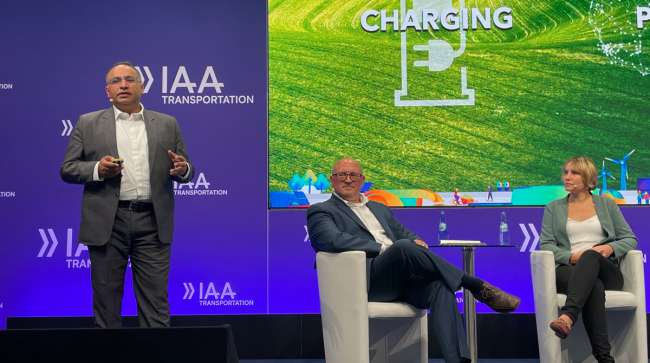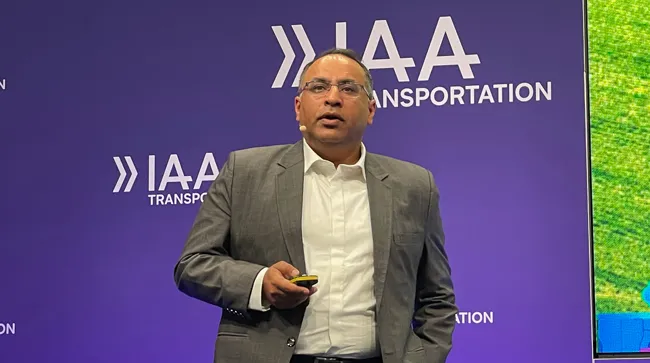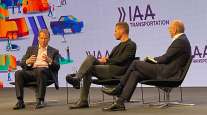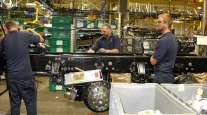OEMs Form Consortium to Standardize EV Truck Charging

[Stay on top of transportation news: Get TTNews in your inbox.]
HANOVER, Germany — Charging is one of the biggest challenges associated with electrification, and original equipment manufacturers are leading a consortium to help standardize electric vehicle supply equipment and the charging experience for drivers.
“We did an experiment. We had a guy drive a truck from California to Chicago, and 80% of the time when the guy was trying to charge, he had a bad experience,” said Navtej Singh, director of powertrain engineering research and development for Navistar. “The question comes in, ‘Why is it so hard?’”
The U.S. doesn’t have a standard testing protocol for electric vehicle supply equipment (EVSE), but Singh said dialogue between charging equipment providers and OEMs has to happen.
Navistar, along with Volvo, has joined the Heavy-Duty Charging Consortium as a core member to help address the interoperability issues associated with EVSE.
READ MORE: Charging Infrastructure Limitations Challenge OEMs
“Our first step is to start the consortium, start having a dialog and start generating the standards,” Singh said, adding that Cummins Accelera is a supporting member.

Navistar found that the vast majority of charging experiences are negative, Singh said. The consortium aims to change that. (Mindy Long/Special to transport Topics)
The consortium held its first meeting in early September in Detroit. The goal is to create a Design Verification Plan and Report — an engineering planning tool for the systematic identification of required tests and validations — and develop interoperability standards for EVSE to make back-of-the-fence depot charging and public charging seamless for the driver.
In an interview after the session, Singh told Transport Topics he hopes to get more OEMs involved. The consortium expects to release its first white paper in February and its first SAE standards for SAJ suppliers in March or April. The consortium also plans to address ease of payment and the use of apps.
READ MORE: Component Manufacturers Unveil Green Tech at IAA 2024
“Why can’t an app be used through multiple EVSE [providers]? Why does everyone have to have their own app? The goal is for all of the EVSE to be lined up,” Singh said. “There will be a shake hand needed between EVSE guys to have a common portal.”
Tim Yerdon, executive director for SAE Industry Technologies Consortia, said standardization will help the industry scale, and the consortium will help speed standards development. “The typical standard development process is two to three years with volunteer members in volunteer standard bodies,” he said.
Want more news? Listen to today's daily briefing above or go here for more info
A consortium can accelerate that time to 12 to 18 months.
“We cut the time to develop standards in half to allow us to get to industry quicker,” Yerdon said. “It benefits us all to do that and have a common footprint, common language, common technology discussions.”
Anne-Lise Deraedte, vice president of charging EMEA, for Einride, a Swedish transport company specializing in electric and self-driving vehicles, said EVs require a new way of thinking for all stakeholders.
“We’re combining three industries that aren’t used to working together — the infrastructure, the energy companies and the transport,” she explained.
READ MORE: Low-Voltage Power Demands Are Driving New Battery Solutions
Standardization can benefit electrification everywhere, but especially in the U.S. where the heavy-duty market is about equal to the whole market of Europe.
“Think about what the U.S. has to do,” Singh said while speaking at IAA Transportation 2024 on a panel on charging. “We have multiple interfaces. Then we have adapters. Then we have multiple specifications — SAE, DIN and ISO, and Tesla has their own.”
Singh said he isn’t trying to paint a “doom picture” but stressed that the industry needs to know where it stands to start fixing the problems.
“It’s a journey,” he explained, “and we are learning what we have to do.”




